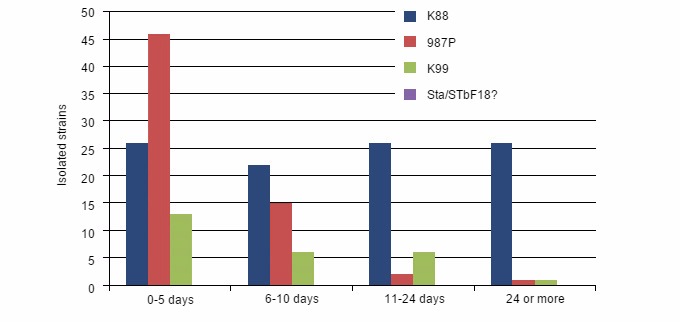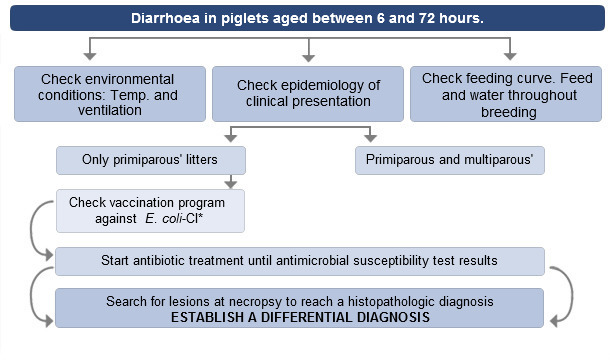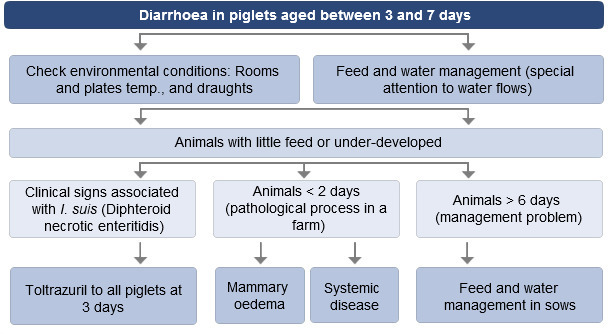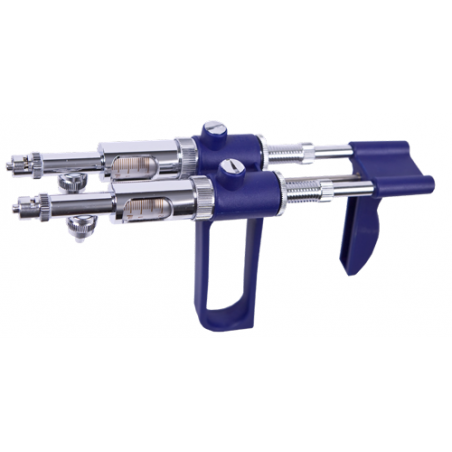In swine pathology, Escherichia coli (E. coli) causes mainly diarrhoeas in the farrowing unit, at weaning and fattening, and oedema disease. Other clinical pictures are more frequently experienced by humans, with bloody diarrhoea, urogenital infections and / or septicaemia.
The most typical clinical manifestation in the farrowing unit is diarrhoea, and the earlier the onset, the more harmful it is. Newborn piglets can present another clinical picture, with signs of sepsis (shock, depression, death, polyarthritis), which is associated with an extraintestinal E. coli (Fairbrother, 2008.)

When facing a case with a clinical picture of diarrhoea, an accurate differential diagnosis is needed. Diarrhoea is a multifactorial disease, so it is essential to find the triggers and boosters to solve the problem successfully.
Differential diagnosis
Table 1 outlines the possible causes of diarrhoea differentiating the resulting diarrhoea by its appearance, time of onset and parity number.
Table 1. Check list for the differential diagnosis of diarrhoea in lactation.
| Clinical sign | Animals affected | Possible cause | Corrective action | |||||
| Diarrhoea | Appearance | Age | Sows | Vaccination | Treatment | Antibiotic | Others | |
| Watery and yellowish | 0-3 days | Primiparous | E Coli Rotavirus |
Commercial vaccine and booster | Oral and injectable antibiotic | Quinolones Cephalosporines |
Feedback and vaccination | |
| Primiparous and multiparous | E Coli, Rotavirus, TGE, PED | Feedback in pregnant sows (Intestinal content only, never intestinal mass) |
||||||
| Brown, blood Gas |
0-7 days?? | Primiparous and multiparous | Clostridium Spp | Commercial vaccine and booster | Oral and injectable antibiotic | Beta-lactam antibiotics | All in / all out in all cases | |
| White | >7 days | Primiparous and multiparous | Coccidios Clostridium A |
- | Toltatruzil Antibiotherapy |
Optimize hygiene and disinfection | ||
| Runt | 0-2 days | Lactactional failure | Antibiotics + anti-inflammatory agents | Review MMA syndrome | ||||
| > 5 d-wean | Feed and water management Temperatures in the room |
Corrective actions | Feeding curves. Water flow rates. Feed hygiene. | |||||
| 1 d-wean | Systemic disease PRRS | Vaccination Stabilization |
||||||
| Respiratory | Coughing | Dust or poor environmental conditions | Correction of environmental causes | |||||
| Fever | Flu and PRRS (main agents) | Health stabilization of the farm | ||||||
During the first week of life diarrhoea caused by E. coli is yellowish and usually quite watery, as opposed to the diarrhoea caused by Clostridium, which is brown and may have traces of blood. When it comes to rotavirus diarrhoea, it appears mainly in primiparous. Differential diagnosis when the diarrhoea is caused by the PED virus is easy given the epidemic nature of it, although there are already many farms where it is endemic. When the diarrhoea is due to systemic diseases such as PRRS outbreaks, it can be persistent and is caused mainly by proliferation of pathogenic strains of E. coli.
When the diarrhoeas affect the farrowing unit from the first week of life, those produced by E. coli become more pasty and can be confused with those produced by Clostridium type A (alpha toxin) and by Isospora suis and Eimeria spp. Morbidity is similar to that of first week diarrhoeas, but mortality is much lower —if appropriate antibiotic coverage is provided—, although they lead to significant growth retardation.
Preferred laboratory techniques
| E. coli | Culture and isolation / PCR for virulence factors |
| Cl. perfringens, Cl. difficile | Culture and toxin identification |
| Transmissible gastroenteritis | PCR |
| Porcine epidemic diarrhoea | PCR |
| Coccidia | Microscopic identification |
| Rotavirosis | PCR |
| Balantidiasis | Isolation and identification |
For practical purposes, anatomical pathology is very complicated, unless we carry out excellent sampling, since the intestine undergoes quick and intense postmortem changes that nonetheless can provide, in many cases, additional very interesting information.

Characterization of pathogenic E. coli
Since most E. coli are commensals and only a few are pathogens, we must typify the different virulence factors to make a diagnosis. As a practical approach, in the field we use the classification of strains by fimbrial (F) antigens or adhesion and colonization factors as a reference.
Table 1. Fimbrial antigens and toxins excreted by E. coli isolated in lactating piglets.
| Fimbrial antigens | Toxins |
| K88(F4) | Sta |
| K99(F5) | Stb |
| 987P(F6) | LT |
| F41 | East1 |

Figure 2. E. coli strains isolated in the field in piglets of different ages from unvaccinated sows.
Source: D. Francis 2008
E. coli with adhesins is found on farms with vaccination failures, mostly K88 and, in less quantity, K99, 987P and, rarely, F41, especially in primiparous. We have never isolated F18 at this age. In vaccinated farms toxins EAST1 (75%) and EAE are identified. In these cases the process of diarrhoea is linked to environmental factors (hypothermia, lack of hygiene or absence of All-in/All-out procedures).
Treatment
First week of life

Figure 3: Decision making process when faced with diarrhoea in up to 72-hour-old piglets.
Source: (Belenguer, Toledo and Finestra, 2014)
The first three days of life are crucial in determining casualties in the farrowing unit. More than at any other time, correcting environmental factors will play a decisive role, therefore temperature control of the plate should be obsessive.
Points to check:
- Implementation of the vaccination program (maternal immunization); colostrum is a serum transudate, so the higher the concentration of immunoglobulins, the greater the protection.
- Consequently, ensuring a good colostrum intake is essential.
- Proper feed back.
- Extreme hygiene and All-In / All-Out. Infection is oral, so reducing the number of E. coli is also essential.
- Sows' feeding. Provide special peripartum feeds to the sow, if necessary.
- Quick antibiotic treatment for the whole litter, first with fluoroquinolones and / or cephalosporins, and then according to antimicrobial susceptibility testing.

Diagram 3: Decision making process when faced with diarrhoea in piglets aged between 3 and 7 days.
Source: (Belenguer, Toledo and Finestra, 2014)
Between 3 and 7 days:
- Continued review of sows' feeding.
- Water quality and supply.
- Oral or parenteral antibiotics.
- Rehydration solutions.
- Avoid mixing litters to avoid increasing the infection pressure.
Second week of life onwards
E. coli often complicates other processes at this age so, until they are corrected, antibiotic therapy should be used. If E. coli is the main causative agent, the effectiveness of maternal immunity and environmental factors must be reviewed.




